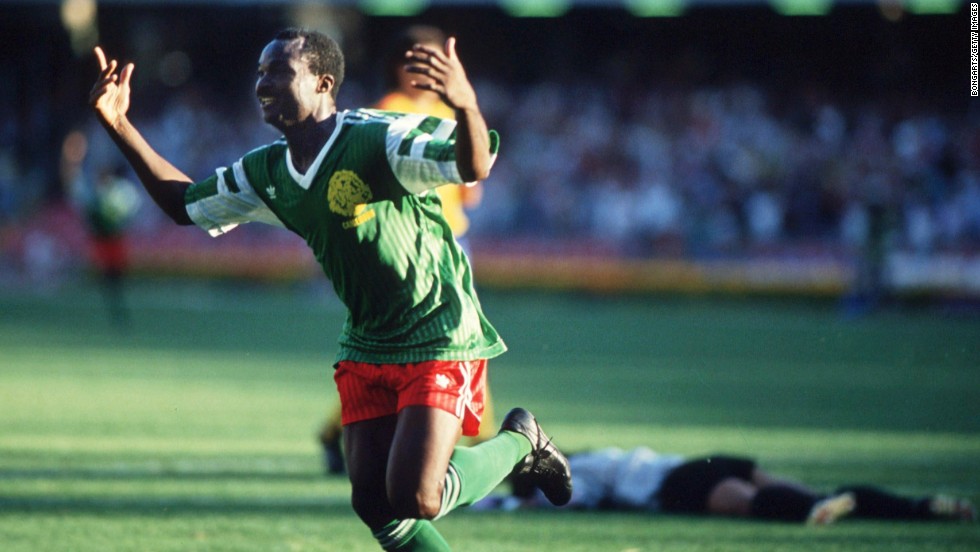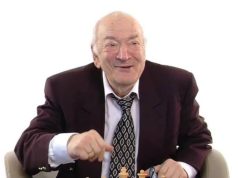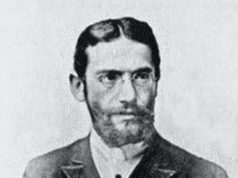Aged 38, Albert Roger Mooh Miller, became one of the oldest to play in the World Cup. Better known as Roger Milla, he became the oldest player to score in a World Cup in 1990. He even topped that feat in the United States at the 1994 tournament, when aged 42 years and 39 days, he scored against Russia.
Born in the Cameroon capital of Yaounde, Roger Milla had a mobile childhood. He played Football in different clubs and was always a gifted player from his early days. At the age of 18, he won his first African league championship with club Leopards Douala. In 1976, he won the African Footballer of the Year award and was a part of two Africa Cup of Nations, in 1984 and 1988, and was the top goalscorer in 1986 and 1988.
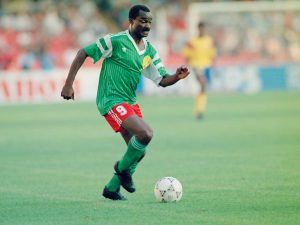 Roger Milla played in Europe for different French clubs from 1977. Along with a handsome European experience, he regularly played for the Cameroon national side. He made his World Cup debut in 1973 versus Zaire in a World Cup qualifier. His first World Cup appearance was in 1982 but it turned out to be a disappointing outing for Cameroon. Having a goal being disqualified against Peru in their first match, the African nation had three draws from their three first-round games. Cameroon exited only not to return to the world stage till 1990.
Roger Milla played in Europe for different French clubs from 1977. Along with a handsome European experience, he regularly played for the Cameroon national side. He made his World Cup debut in 1973 versus Zaire in a World Cup qualifier. His first World Cup appearance was in 1982 but it turned out to be a disappointing outing for Cameroon. Having a goal being disqualified against Peru in their first match, the African nation had three draws from their three first-round games. Cameroon exited only not to return to the world stage till 1990.
After playing for almost 15 years for his country, Roger Milla announced his retirement and moved to Indian Ocean island Reunion, near Madagascar, to play for an amateur side Jeunesse St Pierroise. But as Cameroon qualified for the 1990 World Cup, The President, Paul Biya, himself called Milla and requested him to come out of international retirement to become the flagbearer for his country’s World Cup campaign.
Milla not only answered his country’s call but delivered with such class that the 1990 edition is often remembered as his World Cup. However, the coach initially did not depend on him due to the age factor. Milla was was part of the last nine minutes in Cameroon’s opening match against Argentina. The match result was a shock to the entire world as the defending champions were crushed by the African nation by a winner from Omam-Biyik.
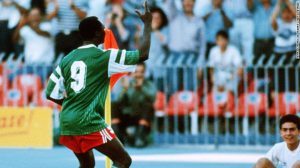
In their next match, Cameroon was suppressed by the Romanian side featuring the likes of Gheorghe Hagi Marius Lacatuş and Gica Popescu, Thomas N’Kono. Milla was in the reserve bench for the first 58 minutes. But as the suppression continued, the coach eventually summoned him from the bench.
Roger Milla took just 18 minutes to pronounce his name at Football’s highest stage. Contesting a high, bouncing ball with Ioan Andone, Milla smashed through the Romanian central defender. He then positioned the ball into the net defeating the goalkeeper Silviu Lung. And then came one of the most celebrated defining moments of 1990 edition. The youth of 38, ran off joyfully towards the corner flag and swayed his hips that became famous as the ‘hip-wiggling celebration’ of Roger Milla.
Later, commenting on his trademark celebration, Milla said, “It was instinct. I couldn’t plan it before the tournament because I didn’t know if the coach was going to pick me to play, and I didn’t know if I was going to score a goal.”
Milla did not stop there. He pocketed the game for Cameroon by scoring the second goal and thus took Cameroon to the next round. Winning the dead-rubber against Soviet Union by 4-0, Cameroon happily placed themselves in the round of 16 against Colombia.
The game progressed exactly like the way against Romania as Milla came off the bench around the 60-minute mark to make all the difference. But this time he could not score in the 90 minute period of the match. The stadium had to wait for the extra time to see Milla’s patent celebration. In the 106th minute a beautiful pass from Omam-Biyik allowed Milla to go past Luis Carlos Perea and Gildardo Gómez. Then a sweet placing of the ball with his left foot leaving Higuita behind was a treat for the spectators. Just three minutes later, Milla took advantage of Higuita’s coming out of the box habit and put Cameroon 2-0 up.
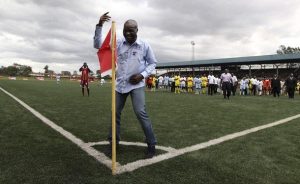
What followed, in both the occasions, was his sprinting to the corner flag and doing his hip-swaying dance. It inspired many songs and dance and was even featured in many commercials. In the quarterfinal match against England, Milla could not score a goal but drew a penalty and then set up a goal for Ekeke in Cameroon’s loss of 3–2, thus ending their dream run. Due to his performances in Italy, Roger Milla was once again named African Footballer of the Year.
Cameroon came back in 1994 World Cup and so did Milla. But they were not even some inch closer to their dream performance of 1990. They were soon eliminated in the group stages. But Roger Milla brought back his swaying dance after the only goal he scored against Russia. The world remembered him and the whole stadium thundered as they witnessed the pioneer of contemporary ‘goal celebration’ celebrating in his characteristic way.

